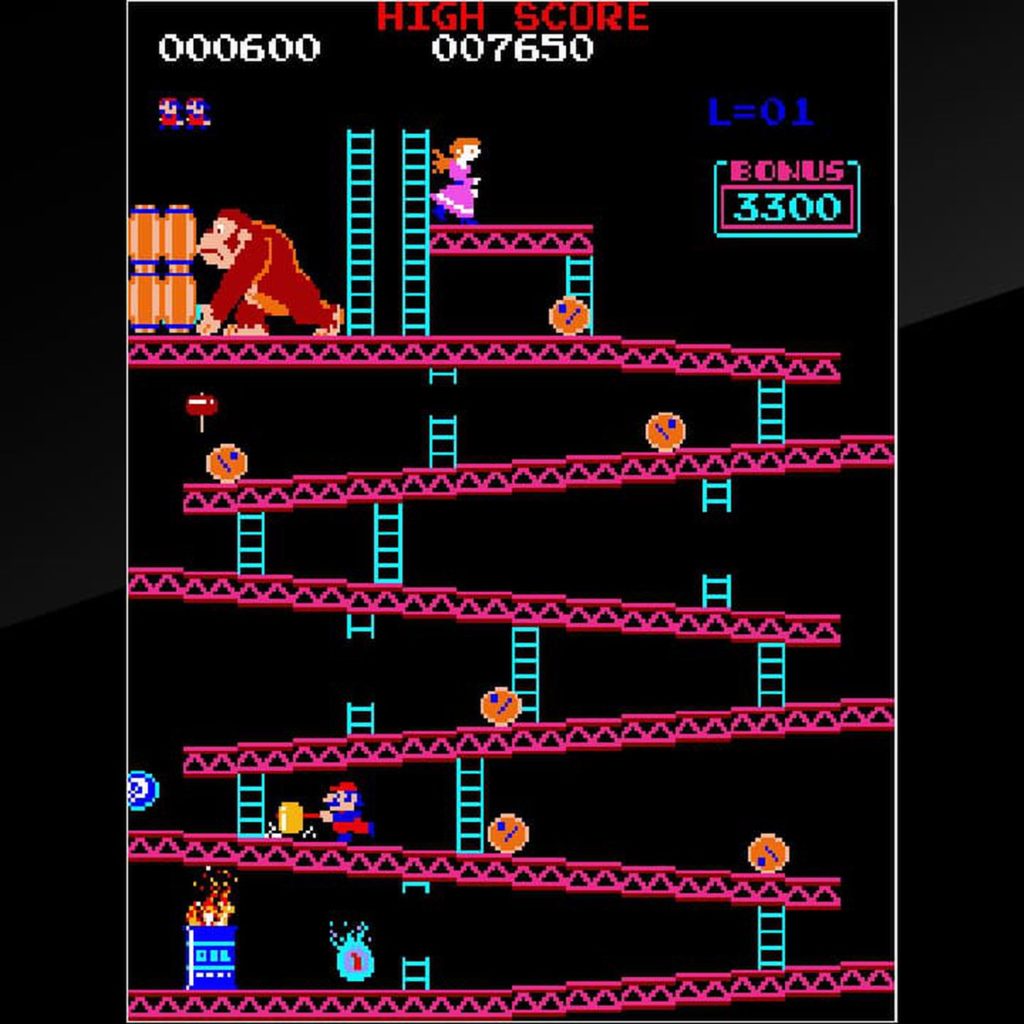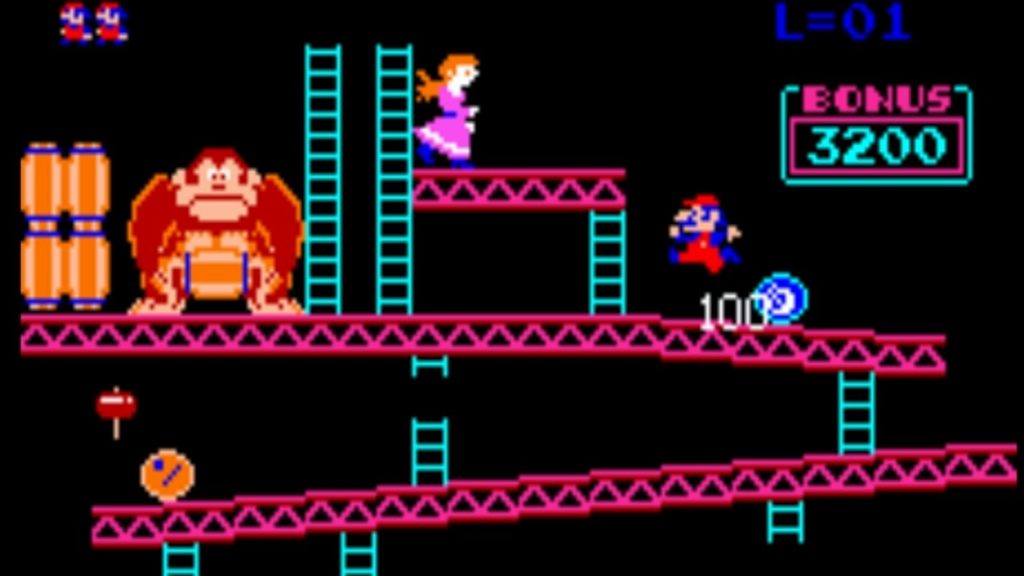History
Donkey Kong, created by Nintendo in 1981, is the first game of the Donkey Kong franchise and the first video game appearance of Mario. DK was an immense commercial success, selling 15 million units worldwide and establishing itself as one of the titans of the golden age of arcade games. In addition, DK helped popularize and innovate platform games during their infancy stage, featuring a fully on-screen narrative while also introducing jumping to the genre.

Game Mechanics
The goal of Donkey Kong is to help Mario rescue Pauline from the eponymous antagonist. The player begins the game with three lives, lost whenever the player touches Donkey Kong or an enemy object, falls too far, or loses their progress on the bonus counter. Some versions of the game grant an extra life at 7,000 points. You gain points by jumping over obstacles, destroying them with a hammer, or collecting items like parasols and hats. DK consists of four unique single-screen stages, each representing a 25-meter increment of the structure that the Donkey Kong climbs. Stage one is set at a construction site, with a series of ladders and platforms Mario must ascend to reach Pauline. Stage two involves climbing a structure of moving conveyor belts filled with cement pans. The third stage is composed of elevators and dangerous bouncing springs. The final stage requires removing rivets from the platforms supporting Donkey Kong; Donkey Kong then falls, and Mario can rescue Pauline. These four stages combine to form one level, and subsequent levels recycle the same stages at increasingly higher difficulty levels. In later stages, Donkey Kong develops new mechanics, hurling objects diagonally and at faster speeds; if you (somehow) survive until level 22, the game ends with an unavoidable kill screen. I say somehow because I usually die before level five. Stupid conveyor belts.

Argument
DK’s success provided Nintendo with one of the world’s most recognizable mascots and decades of dominance through the highest-grossing video game series of all time. But it was not the titular character who they built a company around. It was his antagonist.
Aside from Pac-Man, Mario is the most popular video game character in history. Donkey Kong is a well-known character in his own right, but most people only know him as one of the side characters populating games like Mario Kart. While DK spawned a series of games centered on its titular character, his installments are overshadowed by the gargantuan Super Mario Bros. universe. Although Donkey Kong’s villain status has faded over time, his popularity has also taken a complete backseat to that of his first adversary. The story of Mario and Donkey Kong transcends their first collaboration and reverberates throughout both their franchises. It is a classic tale of two parties, usually entrepreneurs, coming up with a revolutionary idea only for one to become rich and famous while the other is penniless. This situation has been widely explored in movies throughout the years but has taken center stage recently in films like Free Guy (2021) and Ready Player One (2018). Both films center on massive video game franchises. Coincidence? Perhaps. Or perhaps not.
The best parallel of Donkey Kong and Mario is a movie it clearly inspired: Wreck it Ralph (2012). The film features a game about a massive, monstrous antagonist (Ralph) trying to destroy an apartment building while the playable hero character (Fix it Felix) uses a magic hammer to fix his damage. Subtle, I know. Wreck-it-Ralph follows Ralph’s journey of self-discovery as he struggles to define himself outside of his villain label. Felix, the in-universe “hero,” is a side character, while the “villain” is the movie’s protagonist. Donkey Kong is undoubtedly the antagonist of DK, kidnapping Mario’s girlfriend and then attempting to kill him. Mario, originally a carpenter instead of a plumber, is the everyman hero trying to reclaim his lost love. The sparse story portrays Donkey Kong as a force of evil, a kidnapping monster who smiles when Mario dies and kidnaps innocent women. Mario becomes the hero solely because the player controls him and thus shares his goals. Donkey Kong Jr, the direct sequel to DK, follows Donkey Kong’s son as he tries to rescue his father from Mario. This game, alongside Donkey Kong II and Donkey Kong Circus, marks Mario’s only three appearances as an antagonist. Is Donkey Kong to blame for the perspective of the original DK? Perhaps he knew that the nameless protagonist would develop a name, brand, and massive cult following within a few years. Mario overshadows Donkey Kong in his own game and then unceremoniously thrusts him from the spotlight. Surely that justifies throwing a few oil drums.
Ultimately, Donkey Kong is the de facto antagonist of his game, painted in a villainous light with no ability to share his perspective on the events. Mario is the de facto protagonist, performing a noble (albeit sexist) act. In DK’s narrative, Mario is the hero, and Donkey Kong is the villain. But these two business partners founded the biggest franchise in the history of video games, and Mario reaps most of the rewards. Nintendo could have given Donkey Kong a character, a motivation, or even a chance. Instead, Mario stole that opportunity from him. So who is the true villain of this story?
